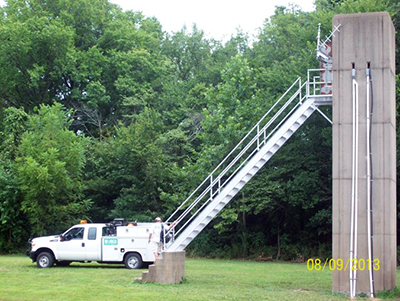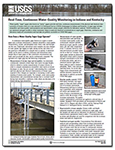

| Stream Data: | Gage height, discharge, stream velocity |
| Water-Quality Data: | Dissolved oxygen, nitrate plus nitrite, pH, specific conductance at 25°C, turbidity, water temperature |
| Atmospheric Data: | None |
| Latitude: | 37°51'30" |
| Longitude: | 87°24'35" |
| Hydrologic Unit Code (HUC): | 05110005 |
| Datum: | |
| Drainage Area: | 9,181.00 square miles |
| County in which site is located: | Henderson |
| Site managed by: | Murray Field Office |
This station is operated in cooperation with the Kentucky Governor’s Office of Agriculture Policy and the USGS Groundwater and Streamflow Information Program.
The Green River is a large river that originates in South Central Kentucky. It is a tributary of the Mississippi River. The Green River flows westward from its origin through Green River Lake, several Kentucky counties, and into the Ohio River near Spottsville. At its mouth at the Ohio River, the Green River has a drainage area of 9,181 square miles. The largest tributary of the Green River is Barren River, which originates in southern Kentucky and flows northwest across Kentucky to its confluence with the Green River near Woodbury, KY in central Kentucky.
Discrete samples of suspended sediment concentrations and nutrients (phosphorus and nitrate) are collected at this site throughout the range of hydrologic and chemical conditions. Typically, discrete samples are collected more frequently during the growing season. Continuous water-quality measurements and discrete samples collected at a super gage are combined in statistical surrogate models. Models are developed to relate in-stream instrument measurements to analyzed discrete constituent concentrations. After peer review and approval, a model can be used to continuously compute constituent concentrations based upon real-time continuous water-quality measurements.
Delivery of excess nutrients, primarily nitrogen and phosphorus, from the Green River to the Mississippi River is a potential problem. Each year, a hypoxic zone (water without dissolved oxygen) forms in the northern Gulf of Mexico that can cause fish to leave the area and that can cause stress of depth to bottom-dwelling organisms that can’t move out of the hypoxic zone. Hypoxia is believed to be caused primarily by excess nutrients delivered from the Mississippi River in combination with seasonal stratification of Gulf waters. Excess nutrients promote algal and attendant zooplankton growth. The associated organic matter sinks to the bottom where it decomposes, consuming available oxygen. Stratification of fresh and saline waters prevents oxygen replenishment by mixing of oxygen-rich surface water with oxygen-depleted bottom water.
The Lower Green River Basin is a highly agricultural area in Kentucky that was selected as a priority basin for the Mississippi River Basin Healthy Watersheds Initiative (MRBI) led by the Natural Resources Conservation Service. The goal of the MRBI is to improve water quality while maintaining agricultural productivity. Since 2013, the USGS, in cooperation with the Kentucky Governor’s Office of Agricultural Policy, has been measuring continuous nitrate concentrations and computing nitrate loads discharged from the Lower Green River to the Ohio River, a major tributary to the Mississippi River. These data are critical for evaluating the effectiveness of agricultural-nutrient management plans and strategies implemented in the basin.

USGS Fact Sheet 2015-3041 provides more detailed information about super gages, how they operate, and the data they collect.
Indiana:
Tim Lathrop
(317) 600-2782
trlathro@usgs.gov
Kentucky:
Jeff Woods
(317) 600-2762
jwoods@usgs.gov